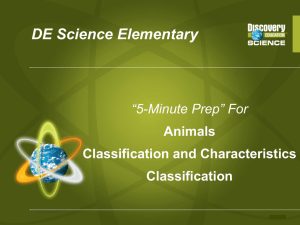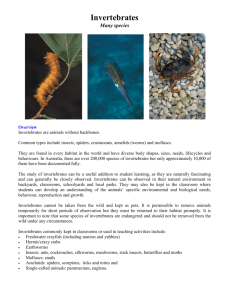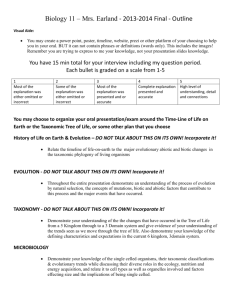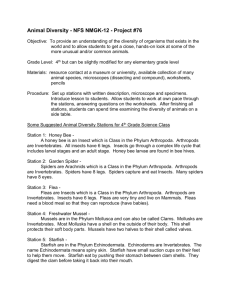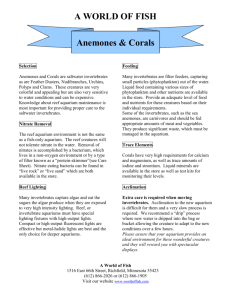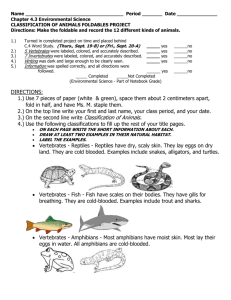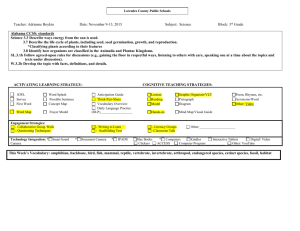Biology 170 Exam 2: Invertebrate Zoology
advertisement
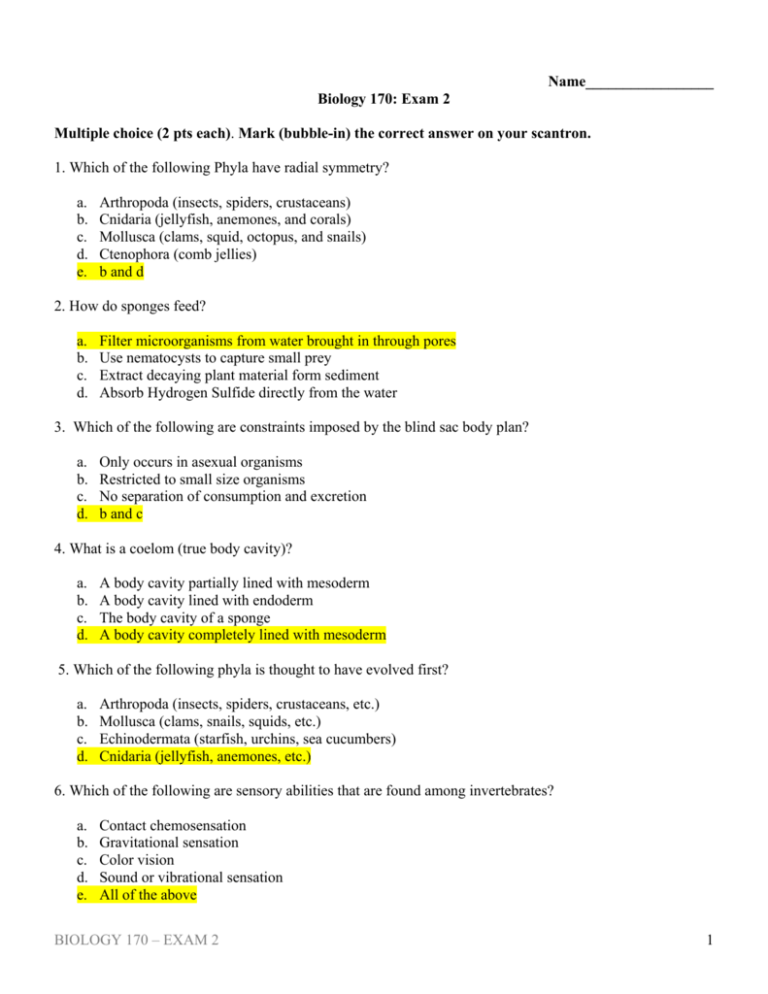
Name_________________ Biology 170: Exam 2 Multiple choice (2 pts each). Mark (bubble-in) the correct answer on your scantron. 1. Which of the following Phyla have radial symmetry? a. b. c. d. e. Arthropoda (insects, spiders, crustaceans) Cnidaria (jellyfish, anemones, and corals) Mollusca (clams, squid, octopus, and snails) Ctenophora (comb jellies) b and d 2. How do sponges feed? a. b. c. d. Filter microorganisms from water brought in through pores Use nematocysts to capture small prey Extract decaying plant material form sediment Absorb Hydrogen Sulfide directly from the water 3. Which of the following are constraints imposed by the blind sac body plan? a. b. c. d. Only occurs in asexual organisms Restricted to small size organisms No separation of consumption and excretion b and c 4. What is a coelom (true body cavity)? a. b. c. d. A body cavity partially lined with mesoderm A body cavity lined with endoderm The body cavity of a sponge A body cavity completely lined with mesoderm 5. Which of the following phyla is thought to have evolved first? a. b. c. d. Arthropoda (insects, spiders, crustaceans, etc.) Mollusca (clams, snails, squids, etc.) Echinodermata (starfish, urchins, sea cucumbers) Cnidaria (jellyfish, anemones, etc.) 6. Which of the following are sensory abilities that are found among invertebrates? a. b. c. d. e. Contact chemosensation Gravitational sensation Color vision Sound or vibrational sensation All of the above BIOLOGY 170 – EXAM 2 1 7. Which of the following are dissimilar in ant and termite societies? a. b. c. d. Caste determination Sex of the workers in colony Chemical trails used to recruit workers a and b 8. Which of the following factors contribute to problems in invertebrate conservation? a. b. c. d. e. Lack of knowledge of invertebrate biology and distribution Collecting and consumption by humans Introduced species Habitat destruction All of the above 9. Which of the following is not a mechanism of asexual reproduction? a. b. c. d. e. Parthenogenesis Fission Budding Hermaphroditism Fragmentation 10. Which of the following animal groups do not display complex life cycles? a. b. c. d. Mammals Cnidaria (anemones, hydroids, jellyfish, corals, etc) Arthropoda (insects, crustaceans, spiders, etc.) Mollusca (clams, snails, squids, etc.) 11. Which of the following is not an advantage of the exoskeleton in arthropods and mollusks? a. b. c. d. Provides protection from predators Provides rigid places for muscles to insert and against which they can do work Enhances sensory perception Permits greater range of movement than body plans without a rigid skeletal structure 12. Why is it impossible to have a single celled organism or an organism with only two tissue layers the size of an elephant? a. Not impossible, just by chance such an animal has never evolved b. Locomotion would be difficult c. Not enough materials could be moved across cell membranes quickly enough to meet nutritional and energetic requirement, nor to remove waste products relative to the mass of such an organism d. Vulnerability to predators BIOLOGY 170 – EXAM 2 2 13. Which of the following phyla do not have blind-sac body plans? a. b. c. d. Annelida (polychaete worms, earth worms, leeches) Platyhelminthes (flatworms) Ctenophora (comb jellies) Cnidaria (anemones, hydroids, corals, jellyfish, etc) 14. Which of the following is not an advantage of the tube-within-a tube body plan? a. b. c. d. Permits specialization of tissues for different functions Allowed sexual reproduction Allowed the development of true muscle tissues permitting greater movement Allowed separation of feeding and excretory pores 15. Which of the following is not a major factor in the success of the Arthropoda (insects, crustaceans, spiders, etc.)? a. Paired jointed appendages b. A chitinous exoskeleton c. Body segmentation and the fusion of body segments into functional regions of the body (head, thorax, abdomen) d. Radial symmetry 16. Within the Bilateria which of the following characters does not distinguish the Protostomes (mollusks, annelids, arthropods) from the Deuterostomes (echinoderms, chordates)? a. Protostomes have spiral and determinate cleavage while Deuterostomes have radial and indeterminate cleavage b. In Protostomes solid masses of mesoderm give rise to coelom, in Deuterostomes folds of archenteron form coelom c. In Protostomes there are only two tissue layers, in Deuterostomes there are three tissue layers d. In Protostomes the mouth develops from blastopore, in Deuterostomes the anus develops from blastopore 17. Which of the following are ways in which the ecology of invertebrates differs from vertebrate animals? a. b. c. d. e. Vertebrates play a larger role in the decomposition of dead plant and animal tissues Invertebrates are more likely to have eruptive population dynamics (large fluctuations in abundance) Invertebrates tend to have complex life cycles with morphologically distinct juvenile and adult stages b and c a and c 18. Which of the following are not arguments that have been made for conserving invertebrate animals? a. b. c. d. e. Invertebrate help prevent overpopulation of the earth by humans Invertebrates are a valuable resource for human use Invertebrates provide valuable ecosystem services It is legally mandated Ethical arguments that all species have a right to existence BIOLOGY 170 – EXAM 2 3 19. Which of the following phyla are not consumed for food by humans? a. b. c. d. e. 20. Cnidaria (jellyfish, anemones, corals, hydroids). Arthropoda (insects, crustaceans, spiders, etc.) Platyhelminthes (flatworms) Echinodermata (starfish, sea cucumbers, sea urchins, etc) Annelida (polychaete worms, earth worms, and leeches) Which of the following is not an ecosystem service provided by invertebrates? a. b. c. d. Decomposition of plant and animal tissues Pollination of plants Suppression of herbivorous pests of crops Vectors and intermediate hosts of parasites that attack humans 21. Which of the following are ways that animals obtain energy and nutrients? a. b. c. d. e. Symbiotically from algae By eating the feces of other animals By farming and consuming fungi From symbiotic bacteria that metabolize H2S (Hydrogen sulfide) All of the above 22. Which of the following are not trends observed in the evolution of the central nervous system in invertebrates? a. b. c. d. Increasing size of cerebral ganglia and formation of a “brain” Reduction in the number of nerve chords Replacement of nerve chords by nerve nets Dominance of the ventral pair of nerve chords 23. Which of the following behaviors occur in invertebrates? a. b. c. d. e. Learning Deception Spatial memory Kin recognition All of the above 24. Hamilton’s rule rB > C (where r is the degree of relatedness, B is the benefit to the recipient, and C is the cost to the altruist) predicts that natural selection should favor altruistic acts under certain circumstances. Which of the following circumstances are unlikely to lead to selection favoring altruism? a. b. c. d. B is small C is large r is small All of the above BIOLOGY 170 – EXAM 2 4 25. Which of the following are resources acquired by some invertebrates? a. b. c. d. e. Thermal energy Chemicals for signaling and defense Water Shelter All of the above 26. Which of the following are not social behaviors displayed by some invertebrates? a. b. c. d. e. Parental care Channel surfing Communal nesting Cooperation in brood care between parents and offspring b and d 27. Which of the following are sensory abilities displayed by some insects? a. b. c. d. e. Perception and production of ultrasound Perception of UV radiation Contact chemosensation Perception of vibrations All of the above 28. Euglandina, a snail, caused the extinction of species of native snails in the genus Partula on the island of Morea. By what mechanism did these extinctions occur? a. b. c. d. Habitat destruction Predation Pollution Competition 29. Which of the following are not methods that invertebrates have employed to escape predators? a. b. c. d. e. Warning coloration Feeding in the daytime Crypsis and camouflage Spines and shells Chemical exudates 30. Which of the following are not items that animals must obtain through their diet? a. Carbohydrates, proteins, and fats b. Essential amino acids c. Minerals d. Non-essential fatty acids BIOLOGY 170 – EXAM 2 5 II. True or false (2 points each). Mark (bubble in) “a” for True and “b” for false on your scantron. 1. The Arthropoda and the Nematoda are the two largest (number of species) phyla that comprise the Ecdysozoa. A. True 2. The Porifera (sponges), Cnidaria (jellyfish, anemones, etc.) and Platyhelminthes (flatworms) are phyla with radial symmetry. B. False 3. Primitive nervous systems in invertebrates consisted of a single ventral nerve chord and more recently evolved nervous systems consist of nerve nets. B. False 4. Invertebrates act reflexively – that is they behave in a specific manner when confronted with specific sensory information their central nervous system does not integrate information sensory structures leading to context dependent behavior. B. False 5. Haplodiploidy is the situation in Hymenoptera (bees, ants, wasps) where females have one set of chromosomes and are produced from unfertilized eggs, and males have two sets of chromosomes and are produced from fertilized eggs. B. False 6. Complex social (eusocial) behavior only occurs in invertebrates that have a haplodiploid mechanism for sex determination. B. False 7. Alternation of generations refers to the alternation of sexual and asexual stages in the life cycles of Hydrozoans (hydroids), aphids, and Cynipid wasps. 8. Many groups of invertebrates including Platyhelminthes (flatworms) are hermaphroditic, they may be simultaneously male and female, or they may change sex within their life cycle either from male to female or vice versa. A. True 9. Semelparous refers to animals like spiders that reproduce once and then die, while iteroparous refers to animals that may have several cycles of reproduction and rearing of young before the adults die. A. True 10. A hydrostatic skeleton is an incompressible fluid within a body cavity (gastrovascular cavity, coelom, etc.) against which muscles can do work for body movement or movement of tentacles or a proboscis. A. True 11. Besides their body shape, the phyla within the Radiata differ from the phyla within the Bilateria in that they have only two tissues layers, rather than the three layers that characterize all bilateral phyla. A. True 12. Plague locusts are an example of eruptive population dynamics. A. True 13. Three species of butterflies, the Satyr Butterfly, the Pheres Blue, and the Xerces Blue, once lived in San Francisco and went extinct because of habitat loss. A. True 14. Animals are heterotrophs. They are incapable of producing their own energy and must consume plants or animals to obtain their energy and nutrients. A. True BIOLOGY 170 – EXAM 2 6 15. The spiders and starfish have external digestion. A. True 16. Deposit-feeders, like earthworms, eat their way through dirt or sediments and extract partially decayed organic material consumed along with the soil or sediments. A. True 17. Statocysts are mechanoreceptors that function to provide invertebrates a sense of equilibrium. A. True 18. Crustaceans and insects have single-lens eyes, but jellyfish, spiders, polychaetes, and mollusks have compound eyes. B. False 19. One of the major trends in the evolution of the nervous system and in sensory perception is the trend toward increasing cephalization (concentration of sensory and nervous structures in anterior of body) in invertebrates. A. True 20. Slave making is common among termites, but absent in ant societies. B. False BIOLOGY 170 – EXAM 2 7

